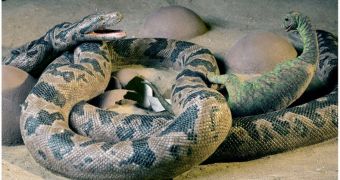For the first time ever, experts have managed to obtain definite proof that ancient snakes were indeed in the habit of eating dinosaur eggs and hatchlings. Some researchers had proposed this idea, but until now no solid piece of evidence has been found to support it. In this study, scientists identified a 67-million-year-old snake fossil, which was curled up around dinosaur eggs, and also around a small hatchling. This unambiguous evidence that snakes consumed dinosaurs before the giant lizards grew beyond the reptile's reach was accepted in the scientific community, Wired reports.
“It’s a stunning, once-in-a-lifetime find. We’ve caught one of the rarest moments in the fossil record, which is prey and predator, together,” University of Chicago paleontologist Paul Sereno, who has not been actively involved in this research, says. Oddly enough, the fossil was first unearthed more than 26 years ago, from a limestone dig site located around the northwestern Indian village of Dholi Dungri. The finding was made by Indian Geological Survey geologist Dhanajay Mohabey, who proposed at first that all of the bones in the trove belonged to dinosaur hatchlings.
The old bones were left to gather dust for many years afterwards, until, back in 2001, University of Michigan paleontologist Jeff Wilson took another shot at deciphering the remnants. The expert and his team investigated the bones more closely, and determined that the fossils also included a snake, coiled up around a number of eggs, as well as around a freshly hatched baby dinosaur. Details of their investigations appear in the March 1 issue of the open-access scientific journal Public Library of Science Biology (PLoS Biology), a magazine of the Public Library of Science.
In addition to discovering a new window into the lives of dinosaurs just before they disappeared at the K-T boundary, some 65 million years ago, researchers hope that analyzing the snakes even further will give them more clues as to how these reptiles appeared and evolved. The creatures appear in the fossil record beginning some 98 million years ago, but complete specimens are incredibly rare, therefore studies of the species' emergence have been stifled by the lack of proper research materials. “A lot of their early origins are uncertain. More fossils from an early time help put together a picture of snake evolution,” Wilson adds.

 14 DAY TRIAL //
14 DAY TRIAL //